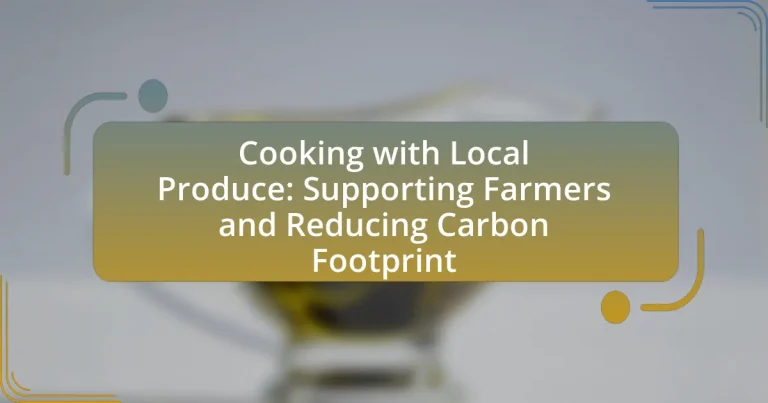Cooking with local produce involves utilizing ingredients sourced from nearby farms, which supports local economies and reduces the environmental impact associated with food transportation. This practice not only enhances the nutritional value and flavor of meals but also strengthens community ties and promotes sustainable agricultural practices. The article explores the economic benefits for farmers, the importance of reducing carbon footprints, and the role of local sourcing in food security. Additionally, it provides practical tips for incorporating local produce into cooking, addressing challenges such as seasonal availability, and dispelling common misconceptions about local food.

What is Cooking with Local Produce?
Cooking with local produce refers to the practice of using ingredients that are grown or produced within a specific geographic area, typically within a short distance from where they are consumed. This approach not only supports local farmers and economies but also reduces the carbon footprint associated with transporting food over long distances. Studies indicate that local produce often has higher nutritional value due to its freshness and shorter time from farm to table, making it a healthier choice for consumers.
How does cooking with local produce support farmers?
Cooking with local produce directly supports farmers by increasing their sales and providing them with a stable income. When consumers choose to buy and cook with locally sourced ingredients, they contribute to the local economy, ensuring that more money stays within the community. According to a study by the American Farmland Trust, local food systems can generate up to four times more economic activity compared to conventional food systems. This economic boost helps farmers sustain their operations, invest in better farming practices, and maintain their land, ultimately promoting agricultural viability.
What are the economic benefits for local farmers?
Local farmers experience several economic benefits, including increased income from direct sales, reduced transportation costs, and enhanced market access. Direct sales through farmers’ markets or community-supported agriculture (CSA) programs allow farmers to retain a larger share of the consumer dollar, often resulting in higher profit margins compared to wholesale distribution. Additionally, by sourcing locally, farmers save on transportation expenses, which can significantly impact their overall profitability. Studies indicate that local food systems can boost local economies by keeping money within the community, as consumers are more likely to reinvest in local businesses.
How does local sourcing impact community relationships?
Local sourcing strengthens community relationships by fostering economic ties and enhancing social cohesion. When businesses prioritize local suppliers, they contribute to the local economy, which can lead to job creation and increased financial stability within the community. For instance, a study by the American Independent Business Alliance found that local businesses recirculate a greater share of every dollar as they create locally owned supply chains, which supports community development. Additionally, local sourcing encourages collaboration among community members, as businesses and consumers engage more directly with local producers, leading to stronger interpersonal connections and a sense of shared purpose.
Why is reducing carbon footprint important in cooking?
Reducing carbon footprint in cooking is important because it minimizes greenhouse gas emissions associated with food production and preparation. Cooking methods and ingredient sourcing significantly impact carbon emissions; for instance, using local produce reduces transportation emissions, which account for a substantial portion of a food’s carbon footprint. According to a study by the Food and Agriculture Organization, transportation can contribute up to 11% of the total greenhouse gas emissions from food systems. By prioritizing local ingredients and energy-efficient cooking techniques, individuals can contribute to a more sustainable food system and combat climate change effectively.
What are the environmental impacts of food transportation?
Food transportation significantly contributes to environmental impacts, primarily through greenhouse gas emissions, resource consumption, and habitat disruption. The transportation of food often involves long distances, which increases carbon dioxide emissions; for instance, transporting food over 1,500 miles can result in emissions of up to 11 times more CO2 compared to local sourcing. Additionally, food transportation requires substantial energy, often derived from fossil fuels, leading to further depletion of natural resources. Furthermore, the infrastructure needed for food transport, such as roads and warehouses, can disrupt local ecosystems and wildlife habitats. These factors collectively highlight the environmental consequences of food transportation, emphasizing the benefits of sourcing food locally to mitigate these impacts.
How does local produce contribute to sustainability?
Local produce contributes to sustainability by reducing transportation emissions and supporting local economies. When food is grown and consumed locally, it minimizes the distance it travels, which significantly lowers carbon emissions associated with transportation. According to a study by the USDA, food that travels an average of 1,500 miles to reach consumers generates more greenhouse gases compared to locally sourced food. Additionally, purchasing local produce supports local farmers, which helps maintain agricultural diversity and promotes sustainable farming practices. This local economic support fosters community resilience and encourages environmentally friendly farming methods, further enhancing sustainability.

What are the benefits of using local produce in cooking?
Using local produce in cooking enhances freshness and flavor while supporting local economies and reducing environmental impact. Freshness is achieved because local produce is often harvested at peak ripeness and delivered quickly, preserving nutrients and taste. Supporting local farmers strengthens community ties and boosts the local economy, as money spent on local goods circulates within the community. Additionally, utilizing local produce minimizes transportation distances, thereby reducing carbon emissions associated with food transport. According to the USDA, food travels an average of 1,500 miles from farm to plate, contributing significantly to greenhouse gas emissions. By choosing local, consumers can actively participate in sustainable practices that benefit both their health and the environment.
How does local produce enhance flavor and nutrition?
Local produce enhances flavor and nutrition by being fresher and more nutrient-dense than items that travel long distances. When fruits and vegetables are harvested at peak ripeness, they retain higher levels of vitamins, minerals, and antioxidants, which contribute to better health outcomes. For example, a study published in the Journal of Agricultural and Food Chemistry found that locally sourced tomatoes have significantly higher levels of vitamin C compared to those shipped from distant locations. Additionally, the shorter time from farm to table means that local produce often has superior flavor profiles, as it is less likely to lose its taste and texture during transportation. This combination of enhanced flavor and nutritional value makes local produce a beneficial choice for consumers.
What are the nutritional advantages of fresh, local ingredients?
Fresh, local ingredients offer superior nutritional advantages due to their higher levels of vitamins, minerals, and antioxidants compared to imported produce. These ingredients are often harvested at peak ripeness, which maximizes their nutrient content; for instance, studies show that fruits and vegetables can lose up to 50% of their nutrients within days of being harvested. Additionally, local produce typically undergoes less transportation time, which helps maintain freshness and nutritional integrity. Research from the University of California indicates that locally sourced foods can contain up to 30% more nutrients than those transported over long distances.
How does seasonality affect the taste of local produce?
Seasonality significantly affects the taste of local produce by influencing the ripeness and freshness of fruits and vegetables. When produce is harvested at its peak season, it typically has higher sugar content, better flavor, and enhanced nutritional value. For example, tomatoes harvested in summer are sweeter and more flavorful compared to those grown in winter under artificial conditions. Research indicates that seasonal produce can contain up to 30% more nutrients than out-of-season varieties, as they are allowed to fully ripen on the plant. This direct correlation between seasonality and taste underscores the importance of consuming local produce at its optimal time for the best culinary experience.
What role does local produce play in food security?
Local produce plays a critical role in food security by enhancing access to fresh, nutritious food while supporting local economies. When communities prioritize local agriculture, they reduce reliance on imported goods, which can be vulnerable to supply chain disruptions. According to the Food and Agriculture Organization, local food systems can improve food availability and affordability, as they often have shorter supply chains that minimize transportation costs and spoilage. Additionally, local produce contributes to biodiversity and resilience in food systems, which is essential for adapting to climate change impacts.
How does supporting local farmers strengthen food systems?
Supporting local farmers strengthens food systems by enhancing food security and promoting sustainable agricultural practices. When consumers buy from local farmers, they contribute to a shorter supply chain, which reduces transportation emissions and preserves the freshness of produce. According to a study by the USDA, local food systems can increase community resilience by providing access to fresh, nutritious food, thereby improving public health outcomes. Additionally, supporting local farmers fosters economic stability within communities, as money spent locally tends to circulate within the community, creating jobs and supporting local economies. This interconnectedness ultimately leads to a more robust and sustainable food system.
What are the implications of local sourcing on food availability?
Local sourcing significantly enhances food availability by reducing transportation time and costs, which leads to fresher produce reaching consumers more quickly. This practice supports local farmers, thereby increasing the diversity of food options available in the community. According to a study by the USDA, local food systems can improve food security by providing access to fresh fruits and vegetables, which are often limited in areas reliant on imported goods. Additionally, local sourcing can mitigate supply chain disruptions, as seen during the COVID-19 pandemic, where local producers were able to meet community needs more effectively than distant suppliers.

How can individuals incorporate local produce into their cooking?
Individuals can incorporate local produce into their cooking by sourcing ingredients from nearby farmers’ markets, community-supported agriculture (CSA) programs, or local grocery stores that prioritize regional products. This practice not only supports local economies but also ensures fresher ingredients, as local produce is often harvested at peak ripeness. Research indicates that consuming locally sourced food can reduce carbon emissions associated with transportation, as food travels shorter distances to reach consumers. Additionally, cooking with seasonal local produce encourages a diverse diet and fosters a connection to the community and environment.
What are effective ways to find local produce?
Effective ways to find local produce include visiting farmers’ markets, joining community-supported agriculture (CSA) programs, and utilizing online platforms that connect consumers with local farms. Farmers’ markets offer a direct way to purchase fresh produce from local growers, often featuring seasonal items that support regional agriculture. CSA programs allow consumers to subscribe to receive regular deliveries of fresh produce directly from local farms, ensuring a consistent supply of local goods. Online platforms, such as localharvest.org, provide searchable databases of farms and markets, making it easier for consumers to locate nearby sources of fresh produce. These methods not only promote local economies but also contribute to reducing carbon footprints by minimizing transportation distances for food.
How can farmers’ markets be utilized for sourcing ingredients?
Farmers’ markets can be utilized for sourcing ingredients by providing direct access to fresh, locally grown produce and other food items. These markets facilitate connections between consumers and local farmers, ensuring that ingredients are seasonal, often organic, and free from long transportation emissions. Research indicates that purchasing from farmers’ markets can reduce carbon footprints significantly, as food travels shorter distances compared to supermarket supply chains. Additionally, sourcing ingredients from these markets supports local economies and promotes sustainable agricultural practices, contributing to environmental health.
What online resources are available for local produce?
Online resources for local produce include platforms like LocalHarvest, which connects consumers with local farmers and markets, and Farmigo, which allows users to order directly from local farms. Additionally, websites such as EatWild provide information on local farms that sell grass-fed and organic products. These resources facilitate access to fresh, locally sourced food, supporting local agriculture and reducing carbon footprints associated with food transportation.
What are some practical cooking tips for using local produce?
To effectively use local produce, prioritize seasonal ingredients to enhance flavor and freshness. Seasonal produce is often harvested at its peak, ensuring optimal taste and nutritional value. For instance, tomatoes are best in summer, while root vegetables shine in fall and winter. Additionally, utilize simple cooking methods like roasting or steaming to preserve the natural flavors and nutrients of local fruits and vegetables. Research indicates that cooking methods such as steaming can retain up to 90% of nutrients compared to boiling, which can lead to nutrient loss. Lastly, consider incorporating local herbs and spices to elevate dishes, as they complement the flavors of fresh produce and support local agriculture.
How can seasonal recipes maximize the use of local ingredients?
Seasonal recipes maximize the use of local ingredients by aligning cooking practices with the natural growing cycles of produce, ensuring that ingredients are harvested at their peak freshness and flavor. This approach not only supports local farmers by creating demand for their crops but also reduces transportation emissions associated with sourcing ingredients from distant locations. For example, utilizing tomatoes in summer when they are abundant locally minimizes reliance on imported varieties, thereby lowering the carbon footprint of the meal. Additionally, seasonal recipes often highlight the unique flavors and characteristics of local produce, fostering a connection between consumers and their regional agricultural practices.
What preservation methods can extend the life of local produce?
Preservation methods that can extend the life of local produce include refrigeration, canning, freezing, drying, and fermentation. Refrigeration slows down the ripening process and inhibits microbial growth, effectively prolonging freshness. Canning involves sealing produce in airtight containers, which can preserve food for years by preventing spoilage. Freezing halts enzymatic activity and microbial growth, maintaining the quality of fruits and vegetables for several months. Drying removes moisture, which is essential for the growth of bacteria, yeast, and mold, thus extending shelf life. Fermentation not only preserves but also enhances the nutritional value and flavor of produce through the action of beneficial bacteria. These methods are supported by food science research, which indicates that proper preservation techniques can significantly reduce food waste and maintain the nutritional quality of local produce.
What challenges might arise when cooking with local produce?
Cooking with local produce can present challenges such as seasonal availability, variability in quality, and limited selection. Seasonal availability means that certain fruits and vegetables may not be accessible year-round, which can restrict menu planning and recipe options. Variability in quality can occur due to differences in farming practices, leading to inconsistent taste and texture. Limited selection may arise in regions where only specific crops are grown, making it difficult to find diverse ingredients for various cuisines. These challenges can impact meal preparation and overall culinary experience.
How can one overcome seasonal availability issues?
To overcome seasonal availability issues, one can utilize preservation techniques such as canning, freezing, and drying to extend the shelf life of local produce. These methods allow consumers to enjoy seasonal fruits and vegetables throughout the year, thereby supporting local farmers and reducing reliance on imported goods. For instance, the USDA reports that freezing can retain the nutritional value of produce for up to a year, making it a viable option for maintaining access to local foods outside of their growing season.
What are common misconceptions about local produce?
Common misconceptions about local produce include the belief that it is always fresher, more nutritious, and more environmentally friendly than non-local options. While local produce can be fresher due to shorter transportation times, this is not universally true, as factors like storage and handling can affect freshness. Nutritional content can vary based on the type of produce and how long it has been stored, meaning that some non-local produce may retain more nutrients if harvested at peak ripeness and transported quickly. Additionally, the environmental impact of local produce can be misleading; for instance, if local farms use intensive farming practices or if the transportation of local goods involves significant carbon emissions, the overall carbon footprint may not be lower than that of sustainably sourced non-local produce.
What are the best practices for supporting local farmers through cooking?
Supporting local farmers through cooking involves prioritizing the use of locally sourced ingredients in meal preparation. By selecting seasonal produce from nearby farms, consumers can directly contribute to the local economy and reduce transportation emissions, which aligns with sustainability goals. Research indicates that purchasing local food can increase a community’s economic resilience, as studies show that for every dollar spent on local food, approximately 67 cents stays within the community. Additionally, engaging in community-supported agriculture (CSA) programs allows consumers to receive fresh produce directly from farmers, fostering a direct relationship and ensuring farmers receive fair compensation.


